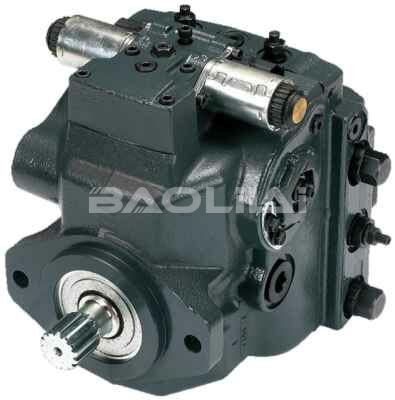How to deal with the bidirectional flow requirements of a plunger pump
A plunger pump is a positive displacement pump that uses a reciprocating plunger to move fluid through the pump. Generally speaking, plunger pumps are designed to move fluid in one direction and are not suitable for reverse flow.
The basic operation of a plunger pump involves the reciprocating motion of a plunger within a cylinder, creating suction that draws fluid into one side of the pump and then pushes fluid out the other side. Pump designs and valves are often optimized for this unidirectional flow.
Attempting to force reverse flow through a piston pump can result in inefficient operation, damage to pump components, or even pump failure. If you need to reverse the flow of a pump, it is recommended to use a pump specifically designed for bidirectional (reversible) flow or to incorporate additional components such as valves to control the direction of flow.
If you have specific needs for bidirectional flow or reversible pumping, you may want to consider a pump designed specifically for such applications. For example, diaphragm pumps are generally better suited for reversible flow because they use flexible diaphragms to create suction and discharge cycles, and the flow direction can be easily controlled through valves.
In reversible pump systems, the design often includes features such as check valves and specific components to achieve smooth and controlled flow in both directions. Diaphragm pumps, peristaltic pumps, and certain types of gear pumps are examples of pumps designed to handle reversible flows more easily.
When considering a pump for a specific application, it is critical to evaluate the specific requirements of the system, including required flow, pressure, and whether bidirectional flow is required. Also, pay close attention to the manufacturer's recommendations and specifications to ensure the pump is compatible with your intended use.
H1-P-060-R-A-A-A5-C3-N-D3-K-G1-H3-L-35-L-35-C-M-24-P4-NNN-NNN H1P060RAAA5C3ND3KG1H3L35L35CM24P4NNNNNN
H1-P-060-R-A-A-A5-C3-B-F6-H-G1-H6-L-42-L-42-C-L-24-PN-NNN-NNN H1P060RAAA5C3BF6HG1H6L42L42CL24PNNNNNNN
H1-P-060-R-A-A-A5-C3-B-F6-H-F1-H6-L-42-L-42-C-L-24-PN-NNN-NNN H1P060RAAA5C3BF6HF1H6L42L42CL24PNNNNNNN
H1-P-060-R-A-A-A5-C2-N-F6-H-G1-H6-L-35-L-35-C-L-24-PN-NNN-NNN H1P060RAAA5C2NF6HG1H6L35L35CL24PNNNNNNN
H1-P-060-R-A-A-A5-C2-N-F5-H-G1-H6-K-42-K-42-F-P-24-PN-NNN-NNN H1P060RAAA5C2NF5HG1H6K42K42FP24PNNNNNNN
H1-P-060-R-A-A-A5-C2-N-F5-H-F1-H6-L-40-L-40-C-P-20-PN-NNN-NNN H1P060RAAA5C2NF5HF1H6L40L40CP20PNNNNNNN
H1-P-060-R-A-A-A5-C2-N-F5-H-F1-H6-L-35-L-35-F-P-24-PN-NNN-NNN H1P060RAAA5C2NF5HF1H6L35L35FP24PNNNNNNN
H1-P-060-R-A-A-A5-C2-N-F4-H-G1-H6-L-30-L-30-C-M-24-PN-NNN-NNN H1P060RAAA5C2NF4HG1H6L30L30CM24PNNNNNNN
H1-P-060-R-A-A-A5-C2-N-F4-H-F1-H6-L-25-L-25-C-M-26-PN-NNN-NNN H1P060RAAA5C2NF4HF1H6L25L25CM26PNNNNNNN
H1-P-060-R-A-A-A5-C2-N-D8-K-G1-NN-L-42-L-42-C-P-24-P4-NNN-NNN H1P060RAAA5C2ND8KG1NNL42L42CP24P4NNNNNN
H1-P-060-R-A-A-A5-C2-N-D8-H-G1-NN-L-40-L-40-N-E-20-PN-NNN-NNN H1P060RAAA5C2ND8HG1NNL40L40NE20PNNNNNNN
H1-P-060-R-A-A-A5-C2-N-D8-H-G1-NN-L-35-L-35-F-P-24-PN-NNN-NNN H1P060RAAA5C2ND8HG1NNL35L35FP24PNNNNNNN
H1-P-060-R-A-A-A5-C2-N-D8-H-G1-NN-K-42-K-42-F-P-24-PN-NNN-NNN H1P060RAAA5C2ND8HG1NNK42K42FP24PNNNNNNN
H1-P-060-R-A-A-A5-C2-N-D8-H-G1-H2-K-42-K-42-F-P-24-PN-NNN-NNN H1P060RAAA5C2ND8HG1H2K42K42FP24PNNNNNNN
H1-P-060-R-A-A-A5-C2-N-D8-H-F1-H5-L-42-L-42-N-E-24-PN-NNN-NNN H1P060RAAA5C2ND8HF1H5L42L42NE24PNNNNNNN
H1-P-060-R-A-A-A5-C2-N-D8-H-F1-H5-L-40-L-40-N-E-24-PN-NNN-NNN H1P060RAAA5C2ND8HF1H5L40L40NE24PNNNNNNN
H1-P-060-R-A-A-A5-C2-N-D8-H-F1-H5-L-40-L-40-C-P-20-PN-NNN-NNN H1P060RAAA5C2ND8HF1H5L40L40CP20PNNNNNNN
H1-P-060-R-A-A-A5-C2-N-D6-K-E1-NN-L-35-L-35-C-L-24-P4-NNN-NNN H1P060RAAA5C2ND6KE1NNL35L35CL24P4NNNNNN
H1-P-060-R-A-A-A5-C2-N-D6-H-G1-NN-L-30-L-30-C-L-24-PN-NNN-NNN H1P060RAAA5C2ND6HG1NNL30L30CL24PNNNNNNN
H1-P-060-R-A-A-A5-C2-N-D6-H-G1-H5-L-38-L-38-F-L-24-PN-NNN-NNN H1P060RAAA5C2ND6HG1H5L38L38FL24PNNNNNNN
If you find that a reversible pump is not suitable for your application, another approach may involve incorporating other components, such as a directional control valve, to effectively manage flow direction. These valves can be used to change the direction of flow within a system without relying solely on the design of the pump.
When dealing with bidirectional flow in a pumping system, it is important to consider the following factors:
1. Pump selection: If required, choose a pump designed for reversible flow. Diaphragm pumps, for example, are known for their ability to effectively handle bidirectional flow. Positive displacement pumps such as gear pumps may also be suitable for reversible applications.
2. Valve: Add a check valve or other directional control valve to the system. These valves can be strategically placed to control flow direction, prevent backflow and ensure the pump operates in the intended direction.
3. System design: Consider the overall design of the fluid handling system. The layout and placement of components, including valves and the pump itself, play a vital role in managing bidirectional flow. Proper system design contributes to efficient, reliable operation.

4.Manufacturer’s Guidelines: Always refer to the manufacturer’s guidelines, technical specifications, and recommendations for the specific pump model you are using. Following the manufacturer's instructions ensures optimal performance, longevity and safety of your pumping system.
5. Maintenance: Regular maintenance is crucial for any pumping system. Inspect and replace components as necessary, paying attention to wear and tear that may affect the pump's ability to handle bidirectional flow.
6. Consultation: If you have specific concerns or uncertainties about bidirectional flow in a pump system, consider consulting with an engineer or expert in fluid dynamics. They can provide insights into best practices for your specific application.
7. Flow control device: In addition to valves, you can also consider using flow control devices such as throttle valves or variable frequency drives (VFD). These devices can help regulate flow rates and pressures in the system, allowing for better control of bidirectional flow.
H1-P-060-R-A-A-A5-C2-N-D6-H-G1-H5-L-35-L-35-C-L-24-PN-NNN-NNN H1P060RAAA5C2ND6HG1H5L35L35CL24PNNNNNNN
H1-P-060-R-A-A-A5-C2-N-D3-H-G1-NN-L-35-L-35-F-M-24-PN-NNN-NNN H1P060RAAA5C2ND3HG1NNL35L35FM24PNNNNNNN
H1-P-060-R-A-A-A5-C2-N-D3-H-G1-H3-L-38-L-38-C-M-24-PN-NNN-NNN H1P060RAAA5C2ND3HG1H3L38L38CM24PNNNNNNN
H1-P-060-R-A-A-A5-C2-B-F6-H-G1-H6-L-30-L-30-C-L-24-PN-NNN-NNN H1P060RAAA5C2BF6HG1H6L30L30CL24PNNNNNNN
H1-P-060-R-A-A-A5-C2-B-F4-H-F1-H6-L-42-L-42-C-M-22-PN-NNN-NNN H1P060RAAA5C2BF4HF1H6L42L42CM22PNNNNNNN
H1-P-060-R-A-A-A5-C2-B-F4-H-F1-H6-L-20-L-15-C-M-24-PN-NNN-NNN H1P060RAAA5C2BF4HF1H6L20L15CM24PNNNNNNN
H1-P-060-R-A-A-A5-C2-B-F4-H-F1-H6-K-35-K-20-C-M-24-PN-NNN-NNN H1P060RAAA5C2BF4HF1H6K35K20CM24PNNNNNNN
H1-P-060-R-A-A-A5-C2-B-D8-H-F1-H5-L-28-L-15-F-P-28-PN-NNN-NNN H1P060RAAA5C2BD8HF1H5L28L15FP28PNNNNNNN
H1-P-060-R-A-A-A5-C2-B-D6-H-G1-H2-L-28-L-28-C-L-24-PN-NNN-NNN H1P060RAAA5C2BD6HG1H2L28L28CL24PNNNNNNN
H1-P-060-R-A-A-A5-C2-B-D6-H-F1-NN-L-33-L-33-C-L-24-PN-NNN-NNN H1P060RAAA5C2BD6HF1NNL33L33CL24PNNNNNNN
H1-P-060-R-A-A-A5-C2-B-D3-H-G1-NN-L-35-L-35-C-M-20-PN-NNN-NNN H1P060RAAA5C2BD3HG1NNL35L35CM20PNNNNNNN
H1-P-060-R-A-A-A5-C2-B-D3-H-G1-NN-L-28-L-28-F-M-24-PN-NNN-NNN H1P060RAAA5C2BD3HG1NNL28L28FM24PNNNNNNN
H1-P-060-R-A-A-A5-C2-B-D3-H-G1-NN-L-25-L-25-F-M-24-PN-NNN-NNN H1P060RAAA5C2BD3HG1NNL25L25FM24PNNNNNNN
H1-P-060-R-A-A-A5-C2-B-D3-H-G1-H3-L-33-L-33-F-M-24-PN-NNN-NNN H1P060RAAA5C2BD3HG1H3L33L33FM24PNNNNNNN
H1-P-060-R-A-A-A5-C2-B-D3-H-G1-H3-K-28-K-28-C-M-22-PN-NNN-NNN H1P060RAAA5C2BD3HG1H3K28K28CM22PNNNNNNN
H1-P-060-R-A-A-A5-C2-B-D3-H-G1-H2-L-40-L-40-C-M-32-PN-NNN-NNN H1P060RAAA5C2BD3HG1H2L40L40CM32PNNNNNNN
H1-P-060-R-A-A-A5-C2-B-D3-H-F1-H3-L-38-L-38-C-M-24-PN-NNN-NNN H1P060RAAA5C2BD3HF1H3L38L38CM24PNNNNNNN
H1-P-060-R-A-A-A5-C2-B-D3-H-F1-H2-L-42-L-42-F-M-24-PN-NNN-NNN H1P060RAAA5C2BD3HF1H2L42L42FM24PNNNNNNN
H1-P-060-R-A-A-A5-C2-B-D3-H-F1-H2-L-38-L-38-F-M-24-PN-NNN-NNN H1P060RAAA5C2BD3HF1H2L38L38FM24PNNNNNNN
H1-P-060-R-A-A-A5-C1-N-F5-H-G1-H6-L-42-L-42-F-P-18-PN-NNN-NNN H1P060RAAA5C1NF5HG1H6L42L42FP18PNNNNNNN
8. Pressure relief mechanism: Install a pressure relief valve or other safety mechanism to protect the pump and other components from excessive pressure that may occur during bidirectional flow. This is especially important to prevent damage during unexpected system changes.
9. Material Compatibility: Ensure that all components in the system (including pumps, valves and piping) are compatible with the fluid being pumped. Certain fluids may be more corrosive or abrasive, and using materials that are resistant to these properties can extend the life of your system.
10. Monitoring and Control Systems: Implement a monitoring system that can track pump and overall system performance. This can include pressure, flow and temperature sensors. Having a control system in place allows for real-time adjustments and enhances the overall reliability of a bidirectional flow system.
11. Training and documentation: Ensure operators and maintenance personnel are well trained and have access to appropriate documentation. Understanding the intricacies of a bidirectional pumping system and following established operating and maintenance procedures are critical to its long-term success.
By addressing these additional considerations, you can create a robust bidirectional pumping system that meets your specific requirements while maintaining efficiency, reliability, and safety. Regular monitoring, maintenance and compliance with best practices will contribute to the longevity and optimal performance of your system.
This article is published by the official website of Baolilai Hydraulics, please contact the author and indicate the source for reprinting:https://www.baolilai-pump.cn/news/1172.html






